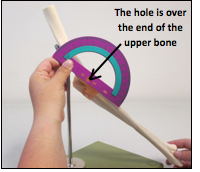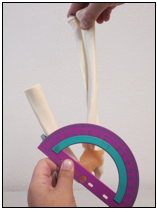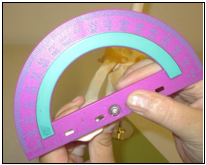Mechanical Station LAB 2.1
Mechanical Systems in Health
Measuring Range of Motion
Understanding Your Joints and Movement
Presentation and Practice
It is important for healthcare workers to understand range of motion and how to measure it. Physical therapists often measure range of motion for specific joints that are painful or diseased. This helps them to see how far along a disease is (such as arthritis), and then design effective treatments for the problems a patient is having.
Measuring Range of Motion
Click Here to download the Answer Sheet for this lab
How to use a protractor to measure angles
A protractor is a tool used to measure the angle between two lines that meet at a point, called the vertex. The best way to learn to use a protractor is to practice. Below is a link to a tutorial and activity that will introduce you to using a protractor. When the web page opens, scroll down the page until you see “GO” in the middle of the page, and click on it.
http://www.abcya.com/measuring_angles.htm
Remember, every joint has a set range of motion. In that range, it can safely move through without hurting the bones or tissues. We can figure out an exact range of motion for a particular joint. We do that by measuring the angle of its full movement from one stopping point to another.
WORK WITH THE JOINT MODELS PROVIDED

Hinge joint – elbow
1. When you are measuring the range of movement for a joint using a protractor, you will have to pick a starting point that will be 0°. Extend the elbow model completely so that it is flat. You may need to remove the model from the stand in order to straighten it completely. We will call this 0° and use it as our starting point. |
2. Place the protractor so that the center is right over the middle of the elbow joint, and the flat end of the protractor is in line with the space between the two forearm bones. Hold it with one hand. |
|
|
3.Bend the elbow until you hit a stopping point. Do not allow the protractor to move. |
4.Look at the number on the rounded side of the protractor that is between the forearm bones. (REMEMBER: whether you choose the larger or smaller number depends on you knowing whether the angle is obtuse or acute. An acute angle will use the smaller number; an obtuse angle will use the larger number.)
5.On your answer sheet, record the angle you found as the range of motion for that joint.
Pivot joint – elbow
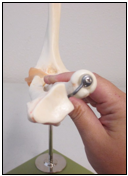 |
1. Again, we must choose a starting point as 0°. We will use the way the forearm bones are normally positioned as the starting point. If you are sitting down, bend the elbow so that you are looking directly at the one metal screw at the end of the forearm. |
2. Place the protractor so that the center is over the metal screw on your right, and so that the flat end of the protractor is in line with the other screw bone. Hold the protractor with one hand. |
|
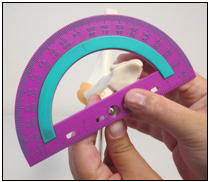 |
|
4. Look at the number on the rounded side of the protractor that is in line with the screw you can see. You may need to guess a little, but you should be able to get close.
5. On your answer sheet, record the angle you found as the range of motion for that joint.
Ball-and-socket joint – hip
Ball-and-socket joints allow movement in many directions, so measuring range of motion would be very difficult!
Remember the three planes of the body and respond to each item:
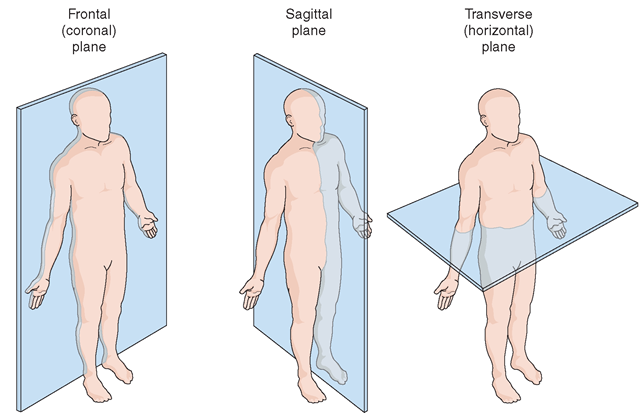
- Experiment with the hip joint model. On your answer sheet, write down whether the hip can move in each of the three body planes.
- For each plane that you can move the hip joint in, describe an activity that requires you to move your leg within that plane. Write these on your answer sheet.
APPLICATION QUESTIONS
- Can you identify another example of a hinge joint, a pivot joint and a ball-and-socket joint? Discuss these with your coach.
- What injuries do you think might occur when someone goes outside of the range of motion for a particular joint? Have you ever had one of these injuries?
EVALUATION
Your lab performance will be evaluated by the criteria (standards) you will find in this project’s rubric. A rubric is simply a table that states how you will be evaluated. Your coach will use this table to report your performance.
CLICK HERE TO GO TO THE RUBRIC
LAB REVIEW
- The total set of positions we can safely make using the joint between two bones is called the range of motion for that joint.
- Each position that you can make with a single joint has an angle that we can measure in degrees.
- The body has three axes (x,y and z) that make up the body’s three dimensions.
- The body also has three planes that split the body into different halves: frontal/coronal, sagittal and transverse.
- Synovial joints have a fluid-filled sac around them to allow gentle free movement between bones.
- Some joints only allow movement in one plane, while others allow movement in two or all three planes.
- There are six types of synovial joints, but the three discussed in this lab are: hinge joints, pivot joints and ball-and-socket joints.
- Going outside of the range of motion for a joint can cause serious damage to the bones or tissues.
__________________________________________
Links to Station 2.1 Modules
Lab Intro | Lab Presentation and Practice | Communications Intro| Communications Presentation and Practice| Math

